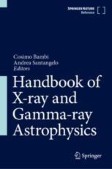Search
Search Results
-
Measurements of the Expansion Velocities of Ionized-Gas Superbubbles in Nearby Galaxies Based on Integral Field Spectroscopy Data
AbstractThe study of dynamic properties of bubbles in the interstellar medium is important for understanding the feedback mechanisms from...

-
Cosmic-Ray Acceleration by Supernova Remnants: Introduction and Theory
In 1934, in the same year that Baade and Zwicky (Proc Natl Acad Sci 20:259, 1934a) first established that there exist a class of very bright novae,...
-
Isolated Neutron Stars
Non-accreting neutron stars display diverse characteristics, leading us to classify them into several groups. This chapter is an observational driven...
-
Isolated Neutron Stars
Non-accreting neutron stars display diverse characteristics, leading us to classify them into several groups. This chapter is an observational driven...
-
Black Holes in Galaxy Mergers
Here we report on simulations which, for the first time, simultaneously track star formation and black hole growth, and associated feedback...
-
Middle-Aged and Old Supernova Remnants
A couple of thousand years after the explosion supernova remnants have swept up considerably more mass than the mass of the supernova ejecta.
-

-
SN 2019edo: A Type II-P Supernova with a Fast Brightness Rise and a Short Plateau Phase
AbstractWe present the results of BVRI photometry for the type II-P supernova (SN) 2019edo in NGC 4162 obtained from April 29, 2019, to January 26,...

-
Radioactive Decay
Radioactive decay of unstable atomic nuclei leads to liberation of nuclear binding energy in the forms of gamma-ray photons and secondary particles...
-
Optical Emission from Supernova Remnants
Several Galactic supernova remnants were known to astronomers as optical nebulae, long before the concept of supernovae and supernova remnants were...
-
Multiwavelength Observations of GRB 181201A and Detection of Its Associated Supernova
AbstractMulticolor photometric observations in the optical band and a comprehensive study in the X-ray, gamma-ray, and radio bands are presented for...

-
Anisotropic Scattering of the Radio Emission of the Pulsar B0833–45 in the Vela Supernova Remnant
Very Long Baseline Interferometry (VLBI) observations of the pulsar B0833–45 have been carried out as part of the scientific program of the...
-
Potentially Primary Xenon Components in Nanodiamond-Enriched Meteorite Fractions: New Isotopic Compositions and Carrier Phases
Abstract —The potential primary component composition of xenon in nanodiamond-enriched fractions (NDFs) of meteorites was determined under the...
-
T Tauri Stars in the Large Magellanic Cloud: A Combined HST and VLT Effort
The combination of the unprecedented spatial resolution attainable with WFPC2 on board HST and of the large collecting area of the VLT makes it...
-
The Close Environment of GRB
We discuss three aspects of the interaction between GRB and their immediate surroundings. Pair production induced by the initial gamma-rays in the...
-

-
Progenitor and Remnant of the Luminous Red Nova V838 Monocerotis
Abstract —The article presents the results of multicolor photometry, medium and low resolution spectroscopy of the red nova V838 Mon remnant for 16...

-
Supernova Remnants as Sources of Cosmic Rays and Nonthermal Emission
Cosmic ray acceleration by astrophysical shocks in supernova remnants is briefly reviewed. Results of numerical modeling taking into account magnetic...
-
Dark gauge boson production from neutron stars via nucleon-nucleon bremsstrahlung
We discuss the dark gauge boson emission from neutron stars via nucleon-nucleon bremsstrahlung. Through the rigorous treatment of the effective field...
-
An extremely energetic supernova from a very massive star in a dense medium
The interaction of a supernova with a circumstellar medium (CSM) can dramatically increase the emitted luminosity by converting kinetic energy to...

